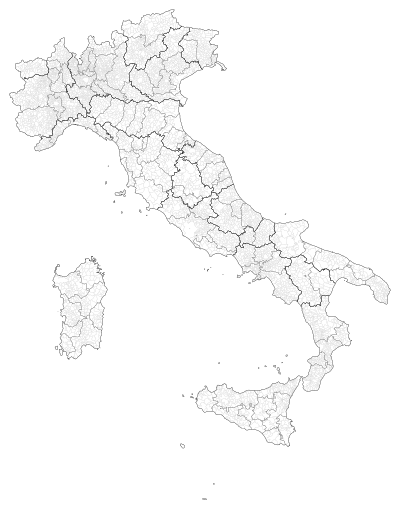Comune

- Regions (black borders)
- Provinces (grey borders)
- Comuni (white division)
The comune (IPA: [koˈmuːne]; plural: comuni, IPA: [koˈmuːni]) is a basic administrative division in Italy, roughly equivalent to a township or municipality.
Importance and function
The comune provides many of the basic civil functions: registry of births and deaths, registry of deeds, and contracting for local roads and public works.
It is headed by a mayor (sindaco) assisted by a legislative body, the consiglio comunale, and an executive body, the giunta comunale. The mayor and members of the consiglio comunale are elected together by resident citizens: the coalition of the elected mayor (who needs an absolute majority in the first or second round of voting) gains three fifths of the Council's seats. The giunta comunale is chaired by the mayor, who appoints others members, called assessori. The offices of the comune are housed in a building usually called the municipio, or palazzo comunale.
As of July 2016 there were 7,998 comuni in Italy; they vary considerably in area and population. For example, the comune of Rome (Lazio) has an area of 1,307.71 km² and a population of 2,761,477, and is both the largest and the most populated comune in Italy; Fiera di Primiero (Province of Trento) is the smallest comune by area, with only 0.15 km², and Pedesina (Province of Sondrio) is the smallest by population, with only 34 inhabitants.
The density of comuni varies widely by province and region: the province of Bari, for example, has 1,564,000 inhabitants in 48 municipalities, or over 32,000 inhabitants per municipality; whereas the Aosta Valley has 121,000 inhabitants in 74 municipalities, or 1,630 inhabitants per municipality – roughly twenty times more communal units per inhabitant. There are inefficiencies at both ends of the scale, and there is concern about optimizing the size of the comuni so they may best function in the modern world, but planners are hampered by the historical resonances of the comuni, which often reach back many hundreds of years, or even a full millennium.
While provinces and regions are creations of the central government, and subject to fairly frequent border changes, the natural cultural unit is indeed the comune – for many Italians, their hometown. In recent years especially, it has thus become quite rare for comuni either to merge or to break apart.
Many comuni also have a municipal police (polizia municipale), which is responsible for public order duties. Traffic control is their main function in addition to controlling commercial establishments to ensure they open and close according to their license.
Subdivisions
A comune usually comprises:
- a principal town or village, that almost always gives its name to the comune; such a town is referred to as the capoluogo (“head-place” or “capital”; cf. the French chef-lieu) of the comune; the word comune is also used in casual speech to refer to the town hall.
- other outlying areas called frazioni (singular: frazione, abbreviated fraz., literally “fraction”), each usually centred on a small town or village. These frazioni have usually never had any independent historical existence, but occasionally are former smaller comuni consolidated into a larger. They may also represent settlements which predated the capoluogo: the ancient town of Pollentia (today Pollenzo), for instance, is a frazione of Bra. In recent years the frazioni have become more important thanks to the institution of the consiglio di frazione, a local form of government which can interact with the comune and show it the local needs, requests and claims. Yet smaller places are called località (literally “localities” and often, as in the phonebook, abbreviated loc.).
- other smaller administrative divisions called municipalità, circoscrizioni, rioni, quartieri, terzieri, sestieri or contrade, which are similar to boroughs.
Sometimes a frazione might be more populated than the capoluogo; and rarely, owing to unusual circumstances or to the depopulation of the latter, the town hall and its administrative functions move to one of the frazioni: but the comune still retains the name of the capoluogo.
In some cases, a comune might not have a capoluogo but only some frazioni. In these cases, it is a comune sparso ("sparse municipality") and the frazione which houses the town hall (municipio) is a sede municipale (compare county seat).
Homonymy
There are not many perfect homonymous Italian municipalities. There are only eight cases in 16 comuni:[1]
- Brione: Brione, Lombardy and Brione, Trentino
- Calliano: Calliano, Piedmont and Calliano, Trentino
- Castro: Castro, Apulia and Castro, Lombardy
- Livo: Livo, Lombardy and Livo, Trentino
- Peglio: Peglio, Lombardy and Peglio, Marche
- Samone: Samone, Piedmont and Samone, Trentino
- San Teodoro: San Teodoro, Sardinia and San Teodoro, Sicily
- Valverde: Valverde, Lombardy and Valverde, Sicily
This is mostly due to the fact the name of the province or region was appended to the name of the municipality in order to avoid the confusion. Remarkably two provincial capitals share the name Reggio: Reggio nell'Emilia, the capital of the Reggio Emilia province, in the Emilian part of the Emilia-Romagna region, and Reggio di Calabria, the capital of the homonymous province. Many other towns or villages are likewise partial homonyms (e.g. Anzola dell'Emilia and Anzola d'Ossola, or Bagnara Calabra and Bagnara di Romagna).
See also
|
- International
- Communes of France
- Municipio, Spanish & Portuguese
- Medieval commune
References
External links
- Associazione Nazionale Comuni Italiani (in Italian).
-
 Media related to Municipalities in Italy at Wikimedia Commons
Media related to Municipalities in Italy at Wikimedia Commons -
 The dictionary definition of comune at Wiktionary
The dictionary definition of comune at Wiktionary
